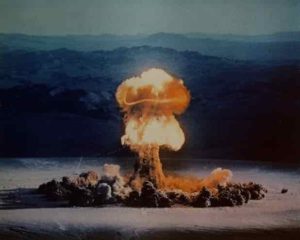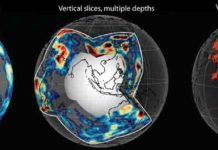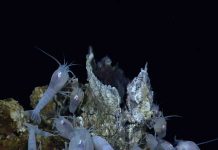
Radioactive carbon released into the atmosphere from 20th-century nuclear bomb tests has reached the deepest parts of the ocean, new research finds.
A new study in AGU’s journal Geophysical Research Letters finds the first evidence of radioactive carbon from nuclear bomb tests in muscle tissues of crustaceans that inhabit Earth’s ocean trenches, including the Mariana Trench, home to the deepest spot in the ocean.
Organisms at the ocean surface have incorporated this “bomb carbon” into the molecules that make up their bodies since the late 1950s. The new study finds crustaceans in deep ocean trenches are feeding on organic matter from these organisms when it falls to the ocean floor. The results show human pollution can quickly enter the food web and make its way to the deep ocean, according to the study’s authors.
“Although the oceanic circulation takes hundreds of years to bring water containing bomb [carbon] to the deepest trench, the food chain achieves this much faster,” said Ning Wang, a geochemist at the Chinese Academy of Sciences in Guangzhou, China, and lead author of the new study.
“There’s a very strong interaction between the surface and the bottom, in terms of biologic systems, and human activities can affect the biosystems even down to 11,000 meters, so we need to be careful about our future behaviors,” said Weidong Sun, a geochemist at the Chinese Academy of Sciences in Qingdao, China, and co-author of the new study. “It’s not expected, but it’s understandable, because it’s controlled by the food chain.”
The results also help scientists better understand how creatures have adapted to living in the nutrient-poor environment of the deep ocean, according to the authors. The crustaceans they studied live for an unexpectedly long time by having extremely slow metabolisms, which the authors suspect may be an adaptation to living in this impoverished and harsh environment.
Creating radioactive particles
Carbon-14 is radioactive carbon that is created naturally when cosmic rays interact with nitrogen in the atmosphere. Carbon-14 is much less abundant than non-radioactive carbon, but scientists can detect it in nearly all living organisms and use it to determine the ages of archeological and geological samples.
Thermonuclear weapons tests conducted during the 1950s and 1960s doubled the amount of carbon-14 in the atmosphere when neutrons released from the bombs reacted with nitrogen in the air. Levels of this “bomb carbon” peaked in the mid-1960s and then dropped when atmospheric nuclear tests stopped. By the 1990s, carbon-14 levels in the atmosphere had dropped to about 20 percent above their pre-test levels.
This bomb carbon quickly fell out of the atmosphere and mixed into the ocean surface. Marine organisms that have lived in the decades since this time have used bomb carbon to build molecules within their cells, and scientists have seen elevated levels of carbon-14 in marine organisms since shortly after the bomb tests began.
Life at the bottom of the sea
The deepest parts of the ocean are the hadal trenches, those areas where the ocean floor is more than 6 kilometers (4 miles) below the surface. These areas form when one tectonic plate subducts beneath another. Creatures that inhabit these trenches have had to adapt to the intense pressures, extreme cold, and lack of light and nutrients.
In the new study, researchers wanted to use bomb carbon as a tracer for organic material in hadal trenches to better understand the organisms that live there. Wang and her colleagues analyzed amphipods collected in 2017 from the Mariana, Mussau, and New Britain Trenches in the tropical West Pacific Ocean, as far down as 11 kilometers (7 miles) below the surface. Amphipods are a type of small crustacean that live in the ocean and get food from scavenging dead organisms or consuming marine detritus.
Surprisingly, the researchers found carbon-14 levels in the amphipods’ muscle tissues were much greater than levels of carbon-14 in organic matter found in deep ocean water. They then analyzed the amphipods’ gut contents and found those levels matched estimated carbon-14 levels from samples of organic material taken from the surface of the Pacific Ocean. This suggests the amphipods are selectively feeding on detritus from the ocean surface that falls to the ocean floor.
Adapting to the deep ocean environment
The new findings allow researchers to better understand the longevity of organisms that inhabit hadal trenches and how they have adapted to this unique environment.
Interestingly, the researchers found the amphipods living in these trenches grow larger and live longer than their counterparts in shallower waters. Amphipods that live in shallow water typically live for less than two years and grow to an average length of 20 millimeters (0.8 inches). But the researchers found amphipods in the deep trenches that were more than 10 years old and had grown to 91 millimeters (3.6 inches) long.
The study authors suspect the amphipods’ large size and long life are likely the byproducts of their evolution to living in the environment of low temperatures, high pressure and a limited food supply. They suspect the animals have slow metabolisms and low cell turnover, which allows them to store energy for long periods of time. The long life time also suggests pollutants can bioaccumulate in these unusual organisms.
“Besides the fact that material mostly comes from the surface, the age-related bioaccumulation also increases these pollutant concentrations, bringing more threat to these most remote ecosystems,” Wang said.
The new study shows deep ocean trenches are not isolated from human activities, Rose Cory, an associate professor of earth and environmental sciences at the University of Michigan who was not involved in the new research, said in an email. The research shows that by using “bomb” carbon, scientists can detect the fingerprint of human activity in the most remote, deepest depths of the ocean, she added.
The authors also use “bomb” carbon to show that the main source of food for these organisms is carbon produced in the surface ocean, rather than more local sources of carbon deposited from nearby sediments, Cory said. The new study also suggests that the amphipods in the deep trenches have adapted to the harsh conditions in deep trenches, she added.
“What is really novel here is not just that carbon from the surface ocean can reach the deep ocean on relatively short timescales, but that the ‘young’ carbon produced in the surface ocean is fueling, or sustaining, life in the deepest trenches,” Cory said.
Reference:
Ning Wang, Chengde Shen, Weidong Sun, Ping Ding, Sanyuan Zhu, Weixi Yi, Zhiqiang Yu, Zhongli Sha, Mei Mi, Lisheng He, Jiasong Fang, Kexin Liu, Xiaomei Xu, Ellen R.M. Druffel. Penetration of Bomb 14 C into the Deepest Ocean Trench. Geophysical Research Letters, 2019; DOI: 10.1029/2018GL081514
Note: The above post is reprinted from materials provided by American Geophysical Union.










